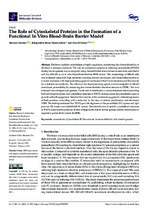| dc.contributor.author | Mentor, Shireen | |
| dc.contributor.author | Makhathini, Khayelihle Brian | |
| dc.contributor.author | David, Fischer | |
| dc.date.accessioned | 2022-01-17T08:28:33Z | |
| dc.date.available | 2022-01-17T08:28:33Z | |
| dc.date.issued | 2022 | |
| dc.identifier.citation | Mentor, S.; Makhathini, K.B.; Fisher, D. The Role of Cytoskeletal Proteins in the Formation of a Functional In Vitro Blood-Brain Barrier Model. Int. J. Mol. Sci. 2022, 23, 742. https://doi.org/ 10.3390/ijms2302074 | en_US |
| dc.identifier.uri | https://doi.org/ 10.3390/ijms2302074 | |
| dc.identifier.uri | http://hdl.handle.net/10566/7098 | |
| dc.description.abstract | The brain capillary endothelium is highly regulatory, maintaining the chemical stability of the brain’s microenvironment. The role of cytoskeletal proteins in tethering nanotubules (TENTs) during barrier-genesis was investigated using the established immortalized mouse brain endothelial cell line (bEnd5) as an in vitro blood-brain barrier (BBB) model. The morphology of bEnd5 cells was evaluated using both high-resolution scanning electron microscopy and immunofluorescence to evaluate treatment with depolymerizing agents Cytochalasin D for F-actin filaments and Nocodazole for α-tubulin microtubules. The effects of the depolymerizing agents were investigated on bEnd5 monolayer permeability by measuring the transendothelial electrical resistance (TEER). The data endorsed that during barrier-genesis, F-actin and α-tubulin play a cytoarchitectural role in providing both cell shape dynamics and cytoskeletal structure to TENTs forming across the paracellular space to provide cell-cell engagement. Western blot analysis of the treatments suggested a reduced expression of both proteins, coinciding with a reduction in the rates of cellular proliferation and decreased TEER. The findings endorsed that TENTs provide alignment of the paracellular (PC) spaces and tight junction (TJ) zones to occlude bEnd5 PC spaces. The identification of specific cytoskeletal structures in TENTs endorsed the postulate of their indispensable role in barrier-genesis and the maintenance of regulatory permeability across the BBB. © 2022 by the authors. Licensee MDPI, Basel, Switzerland. | en_US |
| dc.language.iso | en | en_US |
| dc.publisher | MDPI | en_US |
| dc.subject | Barrier-genesis | en_US |
| dc.subject | Brain endothelial cells | en_US |
| dc.subject | Cytochalasin D | en_US |
| dc.subject | Nanotubules | en_US |
| dc.title | The Role of Cytoskeletal Proteins in the Formation of a Functional In Vitro Blood-Brain Barrier Model | en_US |
| dc.type | Article | en_US |

